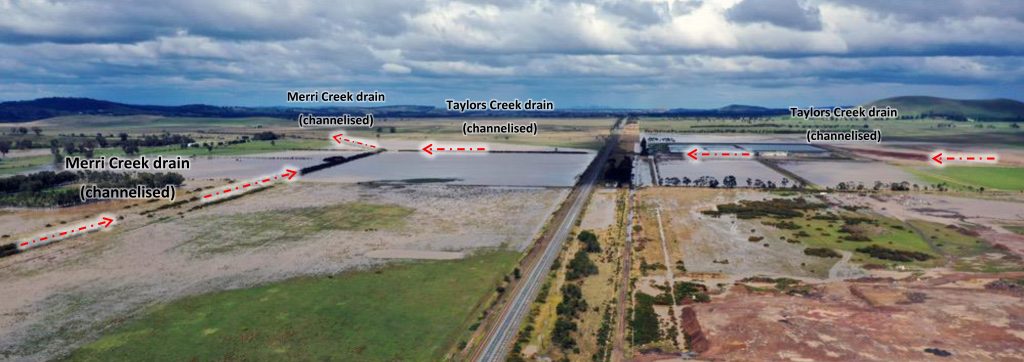It hasn’t been restored yet, so how do we explain the temporary return of Herne Swamp?
After heavy rainfall a few weeks ago north of Melbourne, we got another temporary glimpse of a portion of Herne Swamp, the once expansive (but now artificially drained) natural floodplain wetland at the headwaters of Merri Creek.
For those of you that may have missed it, we introduced Herne Swamp in a blog 12 months ago, where we talked about the risks and opportunities presented by this wetland feature being situated in the heart of Melbourne’s northern growth corridor. And you guessed it, both the risks and opportunities are all about water and how it might be managed in the future.
That is because whenever this catchment receives a heavy downpour, the uplands that surround Herne Swamp (including a series of spectacular volcanic peaks) generate flashy runoff down several creeks and drains that all discharge into this wetland, causing it to temporarily re-inundate, as shown in the image below (see here for the original image and story from The North Central Review):

Even though Herne Swamp was artificially drained in the early 1900s for agricultural development, a combination of downstream constrictions and the limited capacity of the agricultural drains themselves as they pass through the wetland means that the area still inundates. For decades this has been a temporary and regular inconvenience to local farmers – an inevitable consequence of farming in a drained swamp, but also not fundamentally incompatible with this low intensity land-use. However, with Melbourne now rapidly expanding in this direction, times are changing.
Because inundation happens to varying degrees several times a year and is likely to increase in frequency with current and planned future urban and other development in the surrounding catchment, new challenges are on the near horizon.
When you look at the image above, do you see unwanted “flooding” or, conversely, is it much needed “re-wetting” of a drained wetland, just waiting to be brought back to life? It all depends on how you think about the water…
With some simple modifications to design philosophy and integration of this feature into future development, the water you see in this image could readily be turned from a risk into an opportunity – and that is a pretty exciting prospect. We know from previous experience that retaining water in drained wetlands can rapidly unlock self-sustaining ecological benefits, along with a wide range of other critical outcomes for people, water quality and waterway health.
Over the past 12 months, since we first shared this story with you, it has become clear that there is considerable goodwill to try to get the best outcome for Herne Swamp – as well as other natural (but currently drained) wetlands in the upper Merri Creek catchment, which is a fantastic start.
We’ll keep you updated on progress in future blogs.
